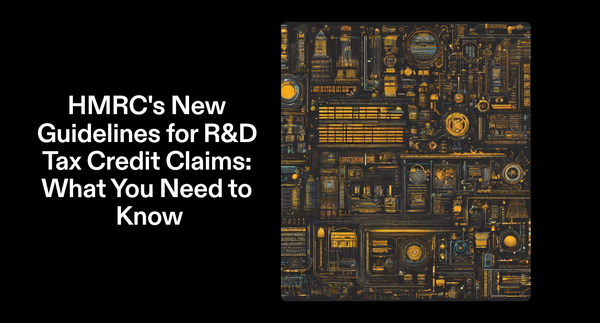R&D Tax Credits & COVID-19: Impact of CJRS and Furlough
On 10 September 2020, HMRC issued their view on how the R&D tax credit relief will be applied to furloughed employees under the Coronavirus Job Retention Scheme (CJRS)

HM Revenue & Customs (HMRC) has recently issued its view on the treatment of staffing costs for furloughed employees in relation to R&D tax credits and here we set out a summary of the key points.
What is the CJRS and Furlough?
The Coronavirus Job Retention Scheme (CJRS) sought to provide financial assistance for employees who could not work during the lockdown (administered by employers via HMRC).
It formed part of a series of measures introduced by the Government designed to help mitigate the negative impact on businesses caused by the lockdown.
Is the Coronavirus Job Retention Scheme (CJRS) Notified State Aid?
No - the CJRS does not constitute Notified State Aid and therefore, State Aid rules are not in point for these purposes (see different rules for Coronavirus Business Interruption Loans (CBILS) below).
However, the CJRS payments from the Government constitute a form of subsidised expenditure and therefore, the general rules that apply for grants and other forms of subsidised expenditure apply here.
Can you claim R&D tax credits for Furloughed Staff?
No — given that a key requirement of the Job Retention Scheme (JRS) was that furloughed employees were not allowed to carry out work during the furlough period, then they cannot have been directly and actively engaged in relevant R&D work during those times.
In the words of HMRC:
As the furloughed employees have ceased all work during the CJRS period HMRC considers that those employees cannot be regarded as being directly or actively engaged in relevant research and development during those times. This means that during those times the conditions in [...] are not being met in respect of their costs. HMRC therefore expect to see these costs excluded from R&D and RDEC claims. This applies equally to furlough payments met under the CJRS and to any ‘top-up’ from the company itself.
What if employees are furloughed, but no Coronavirus Job Retention Scheme payments are claimed?
In this case, it may theoretically still be possible to make an R&D tax credit claim; however, the apportionment rules are likely to result in minimal available staff time spent on qualifying R&D activities given the absence from direct work for the furlough period.
How does holiday pay and sick-leave pay impact on R&D tax relief during furlough?
HMRC accepts that the payment of holiday and sick pay is a normal and necessary cost for businesses and therefore, is allowable as part of the apportionment between qualifying and non-qualifying R&D time.
However, to the extent that such costs are covered by Government payments under the furlough scheme, then these payments will be deemed to be subsidised expenditure and therefore, ineligible for the SME relief (although potentially an apportionment will be allowable under the Research and Development Expenditure Credit (RDEC)).
Can redundancy payments be included in the R&D tax relief claim?
No, the normal rule that redundancy costs are not an allowable staffing cost for R&D tax credit claim purposes applies.
What if my company has claimed the Coronavirus Business Interruption Loan (CBILS)?
The Coronavirus Business Interruption Loan is Notified State Aid for R&D tax purposes.
This means that if the CBILS funds are applied to an R&D project then the entire project is considered to fall outside the SME R&D tax credit incentive - it would then only be possible to claim the less generous RDEC relief on the project.
It is therefore important that companies clearly document how the funding is being used up and to delineate any R&D project work from the day-to-day operational funding of the company.
Cash Flow Planning post COVID-19
Most companies can expect to see a negative impact on claims for the 2020 period given the knock-on effect of lockdown furlough periods resulting in reduced hours and consequent lower apportioned R&D staffing costs.
Although many companies may be able to apply an appropriate proportion of qualifying staffing costs for employees either side of lockdown in their 2020 accounting period, there is still likely to be a lower overall boost to cash flow compared to prior expectations.
As noted above, the impact of CBILS funding and the 'Bounce Back' loan should be carefully considered and documented in terms of how the funding has been deployed. This should help ensure that the relevant State Aid and subsidised expenditure rules can be more accurately applied and help mitigate the risk of tainting R&D claims both now and going forward.
Finally, despite the welcomed recent Government financial support packages, companies should start planning now for cash flow in the 2021 period. As, not only will there be a likely reduction cash from lower (than normal) R&D tax relief claims, but other cash flow strains may also come into play such as deferred VAT payments (that kick-in by 31 March 2021) plus other (as yet) unknowns around the overall economic backdrop (post Brexit...).
Read more: (details in the HMRC Corporate and Intangibles Research and Development Manual (CIRD 83200).





